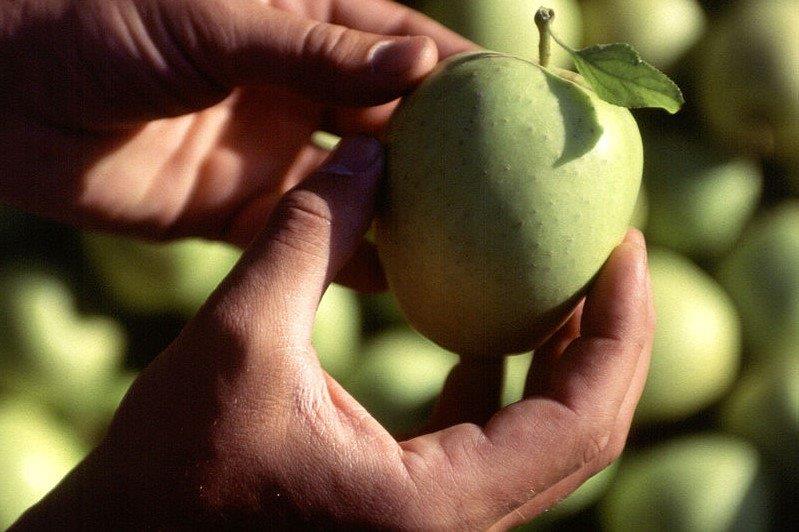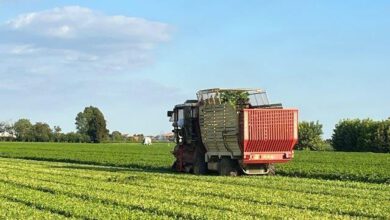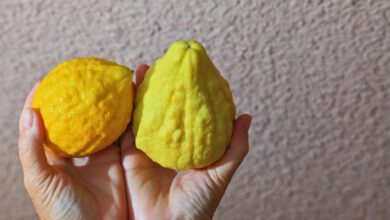Chemical thinning influence on ‘Golden Delicious’ apples Fruit number
Fruit thinning is a common agricultural practice in apple orchards, necessary to ensure profit
Omer Crane, Ayelet Sar Shalom, Yuval Ogny, Northern R&D MIGAL, Galilee Technology Center

Introduction:
Fruit thinning is a common agricultural practice in apple ((Malus X domestica) orchards, necessary to ensure profit. When too many flowers per tree set fruit, small fruits with poor quality will be picked in the first year and too little in the next due to alternate bearing (Wertheim 1999; Haberman et al., 2016). Thinning of fruits during the early stages of growth will overcome these two phenomenon and will ensure high quality fruits in all years.
In Israel the common practice for chemical thinning is 2 applications during the first 21 days after full bloom. The first application is between 3 to 7 days after full bloom with synthetic auxin (mostly 0.4% Agritone which combine both Naphthaleneacetic acid (NAA) and 1-Naphthaleneacetamide(NAD)). The second application is 14 – 21 days after full bloom with either synthetic auxin (NAA 0.1% Alfanol Super or NAD 60 ppm Dilamide) or synthetic Cytokinin (100 ppm 6-Benzylaminopurine (BA)) (Stern et al., 2011 a&b).
Although early thinning, 2 – 4 weeks after full bloom, was found to be beneficial for fruit size and return bloom (stern et al., 2008), uncertainty in chemical intensity, bring farmers to minimize the use of chemical thinning and to rely on hand thinning after ensuring that fruit set is adequate (Wertheim 1999).
The objective of the current research was to characterize the influence of chemical thinning on individual trees, in order to identify potential damage due to over thinning.
Material and methods:
Experiments were conducted during 2012 – 2016. Trees were trained with standard horticultural practices, in a commercial apple orchard at the ‘Matityahu’ research station of the Agricultural Research Organization (ARO), in Northern Israel (3380400400 N, 3582700400 E, altitude 667 m). Trees in the experiment are from the cultivar ‘Golden Delicious’, grafted on M9 rootstock (Malus _ domestica ‘Golden Delicious/M9’), planted in 1997. Trees graded according to their intensity of flowering, from 0 (not flowering) to 5 (strongly flowering) and were chemically thinned according to experimental protocol. Trees were not hand thinned. In each tree 50 inflorescences were marked by ribbons. At the end of June the number of fruits on each inflorescence was counted and at harvest total weight and fruit number were collected for each tree.
Results and discussion:
In order to characterize the influence of chemical thinning on individual trees we have defined its influence on percentage of persisting fruits for 3 successive years (Fig 1).
.jpg) |
Fig 1 – Percentage of persisting fruit in 3 successive years
In 2012 and 2013 the second thinning treatment was with BA and in 2014 with Dilamide. Percentage of persistent fruits was the same (30%) for the control trees in 2012 and 2013 and natural fruit drop was more severe in 2014 with only 20% persisting fruits. In 2012 the effect of the first thinning was milder compared to 2013 and 2014 with 17.4%, 8.8% and 12% persisting fruits, respectively. Accordingly, in 2012 the second thinning lead to further fruit dropout and the rate of persisting fruits was 12% while in 2013 and 2014 no further fruit dropout was evidenced.
Therefore, it can be concluded that both thinning treatments will lead to ˜10% persisting fruits and further decline is not expected. If the reaction to the first thinning treatment is mild, advanced thinning is expected in reaction to the second one. But if a rate of 10% persisting fruits was already obtained by the first treatment, no further fruit drop is expected. This phenomenon is permanent even when natural fruit drop is high.
Although percentage of persisting fruits was similar in all years, the number of fruits per tree was variable as indicated in table 1.
 |
Table 1 – Average number of fruits per tree
This phenomenon had an influence on the final fruit size and fruits harvested in 2014 were small as can be seen by comparing fruit size distribution between years (Fig 2).
.jpg) |
Fig 2 – Fruit size distribution at harvest after 2 thinning treatments at 3 successive years
Since final fruit size that is preferred by the marked in 70 millimeter in diameter it can be concluded that for the current ‘Golden Delicious’, grafted on M9 rootstock trees, 300 fruits per tree is the preferred number for desirable size. This number has no influence on alternate bearing since decrease in return bloom has been observed only when fruits number per tree was above 580 (Fig 3).
.jpg) |
Fig 3 – Percentage of return bloom
From integrating the data above, it was assumed that since percentage of persisting fruits was the same after thinning in all years and fruit number per tree was variable, inflorescence number at bloom is the key factor for determining chemical thinning effect. During 2015 and 2016 we have evaluated inflorescence intensity (see Material and methods) as representing inflorescence number and determined its effect on final fruit number at harvest after chemical thinning (Fig 4).
.jpg) |
Fig 4 – Correlation between inflorescence intensity and fruits per tree
A Significant correlation (R2>0.5) between inflorescence intensity and fruit load at harvest was found for both FB and FB+14 thinning treatments (Fig 4). From analyzing the obtained data, it can be concluded that Agriton thinning will not lead to over thinning (fruit number lower than 300 per tree) when inflorescence intensity is under 2 (very low). A second thinning will not lead to over thinning when inflorescence intensity is lower than 3.
Conclusion:
In the current research it was found that in ‘Golden Delicious’, the percentage of persisting fruits will not go under 10% when using chemical thinning. Therefore 2 treatments for thinning can be applied without concern. Nevertheless, this thinning is not sufficient for high quality fruits when inflorescence is abundant. Since inflorescence intensity is usually higher than 3 in ‘Golden Delicious’ orchards in Israel, hand thinning should be used in completion.




